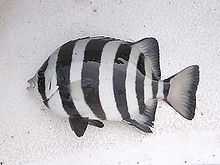Oplegnathus
| Oplegnathus Temporal range: Early Miocene to present[1] | |
|---|---|
 | |
| O. fasciatus | |
| Scientific classification | |
| Kingdom: | Animalia |
| Phylum: | Chordata |
| Class: | Actinopterygii |
| Order: | Perciformes |
| Family: | Oplegnathidae Bleeker, 1853 |
| Genus: | Oplegnathus J. Richardson, 1840 |
| Type species | |
| Oplegnathus conwaii J. Richardson, 1840 | |
| Synonyms | |
| |
Oplegnathus is currently the sole recognized genus in the knifejaw family (Oplegnathidae) of marine perciform fishes.[2] The largest, the Cape knifejaw, can reach a maximum length of about 90 cm (35 in). Knifejaws have teeth fused into a parrot-like beak in adulthood. They feed on barnacles and mollusks, and are fished commercially. They are native to the Indian and Pacific Oceans.
Species
The currently recognized species in this genus are:[3]
- Oplegnathus conwayi J. Richardson, 1840, 1840 (Cape knifejaw)
- Oplegnathus fasciatus (Temminck & Schlegel, 1844) (striped beakfish or barred knifejaw)
- Oplegnathus insignis (Kner, 1867) (Pacific beakfish)
- Oplegnathus peaolopesi J. L. B. Smith, 1947 (Mozambique knifejaw)
- Oplegnathus punctatus (Temminck & Schlegel, 1844) (spotted knifejaw)
- Oplegnathus robinsoni Regan, 1916 (Natal knifejaw)
- Oplegnathus woodwardi Waite, 1900 (knifejaw)
Timeline

References
- ↑ Sepkoski, Jack (2002). "A compendium of fossil marine animal genera". Bulletins of American Paleontology 364: p.560. Retrieved 2008-01-08.
- ↑ Froese, Rainer, and Daniel Pauly, eds. (2014). "Oplegnathidae" in FishBase. February 2014 version.
- ↑ Froese, Rainer, and Daniel Pauly, eds. (2014). Species of Oplegnathus in FishBase. February 2014 version.